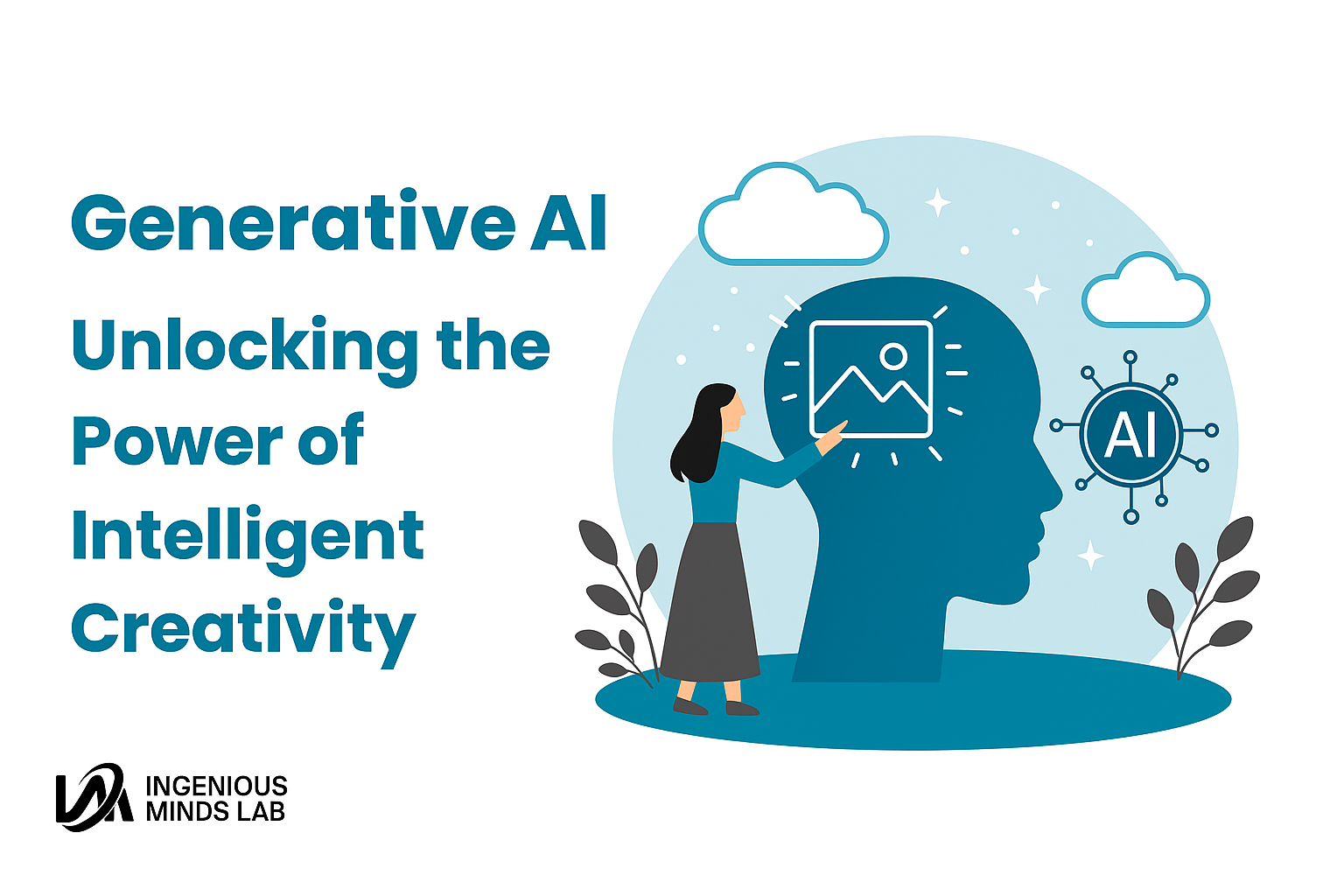Generative AI: Unlocking the Power of Intelligent Creativity
In the world of artificial intelligence, one of the most exciting and transformative developments is Generative AI. From writing poetry to creating realistic images, composing music to generating code, Generative AI is revolutionizing how humans and machines interact with creativity.
This blog will explore what Generative AI is, how it works, where it’s being used, and why it matters for the future of technology and creativity.
What is Generative AI?
Generative AI refers to a class of artificial intelligence models that can create new content, rather than simply analyzing or processing existing data. These models are trained on massive datasets and then use that training to generate text, images, music, video, and even 3D models.
The most well-known examples of Generative AI include:
ChatGPT (OpenAI) – Text generation
DALL·E (OpenAI) – Image creation
Midjourney – Artistic image generation
Stable Diffusion – Open-source image generation
GitHub Copilot – AI code generation
Runway ML – AI video editing
What sets Generative AI apart is its ability to mimic human creativity—fast, scalable, and sometimes indistinguishably real.
How Generative AI Works
Generative AI is powered by models that learn patterns from data and use probabilistic methods to produce new, similar outputs. Here’s a simplified breakdown:
1. Training
Models are trained on large datasets (text, images, audio, etc.) to understand structures, styles, and patterns.
2. Neural Networks
Generative AI often uses transformer-based neural networks, like GPT (Generative Pre-trained Transformer), which are designed to process sequential data and predict the next element (word, pixel, note, etc.).
3. Fine-Tuning
Once pre-trained, the model can be fine-tuned for specific tasks—like summarization, style transfer, or domain-specific creation (e.g., legal writing, medical imagery).
Key Capabilities of Generative AI
✍️ Text Generation: Blogs, books, product descriptions, emails, code
🎨 Image Generation: Art, illustrations, product designs, photo-realistic renderings
🎼 Audio & Music: Generating soundtracks, voice cloning, composing melodies
🎥 Video Generation: Synthetic video creation, animation, and video editing
🧠 Idea Generation: Brainstorming, storytelling, game design ideas
With Generative AI, you don’t just consume content—you co-create it.
Why Generative AI Is a Game Changer
Here’s why Generative AI is being rapidly adopted across industries:
Speeds Up Creative Processes
Writers, designers, and developers can create drafts, assets, or code in seconds instead of hours.Democratizes Creativity
You don’t need to be a professional artist or programmer to bring your ideas to life.Reduces Costs
Automating content creation with Generative AI saves money for startups and enterprises alike.Personalization at Scale
Generate thousands of product ads or email templates, each uniquely tailored to individual users.Innovation Catalyst
New business models and services are emerging, built entirely on top of generative models.
Popular Tools Powered by Generative AI
🧠 Text Generation
ChatGPT – Conversational AI and writing assistant
Jasper AI – Marketing and content creation
Notion AI – AI writing and note-taking
🎨 Image & Art Generation
Midjourney – Artistic, stylized visuals
DALL·E 3 – Realistic and imaginative images
Stable Diffusion – Custom image models, open source
💻 Code Generation
GitHub Copilot – Code suggestions inside your IDE
Replit Ghostwriter – In-browser code generation
Codeium – AI coding assistant for multiple languages
🎬 Video & Audio
Runway ML – AI video editing and synthetic footage
Synthesia – AI avatars and voiceovers for business videos
Soundraw – AI-generated music
Industries Transformed by Generative AI
✍️ Marketing & Advertising
Generative AI creates campaign copy, taglines, visual assets, and A/B test variants at scale.
🛒 E-Commerce
Product descriptions, reviews, and ad creatives can be automatically generated for thousands of SKUs.
📚 Education
AI tutors, quiz generators, and essay graders powered by Generative AI improve learning experiences.
🧬 Healthcare
AI assists in radiology imaging, clinical note writing, and medical research synthesis.
🎮 Gaming
Game developers use Generative AI to create levels, characters, and interactive storylines.
Benefits of Using Generative AI
⚡ Faster Turnaround
Generate full blog posts, illustrations, or videos in minutes.💰 Cost-Efficient
Lower production costs by reducing manual labor in content creation.🔁 Scalable
Whether it’s 10 outputs or 10,000, Generative AI handles it effortlessly.🛠️ Customizable
Train or fine-tune models for your brand’s voice, tone, or style.🎯 Targeted
Hyper-personalize content based on customer data and preferences.
Limitations and Ethical Considerations
As powerful as it is, Generative AI isn’t perfect:
⚠️ Bias & Stereotypes
Models can reflect and amplify societal biases from their training data.⚠️ Plagiarism & Ownership
Who owns the content created by AI? Legal clarity is still evolving.⚠️ Misinformation
AI can create fake news, deepfakes, or misleading visuals if used maliciously.⚠️ Job Displacement
Certain creative or routine tasks may be automated, affecting job markets.
Ethical use of Generative AI requires transparency, human oversight, and clear boundaries.
The Future of Generative AI
The future of Generative AI is limitless, with ongoing research focusing on:
Multimodal AI – Combining text, images, audio, and video in a single model
Real-time Collaboration – AI as a co-creator alongside human artists, developers, and writers
On-Device Models – Smaller, faster models running on your phone or laptop without cloud access
Custom Personal AI – AI that learns from your data to write, think, and speak like you
Generative AI will likely become as integral to productivity as the internet or smartphones.
How to Start Using Generative AI
Interested in trying Generative AI? Here’s how to begin:
Use ChatGPT for writing, coding, or brainstorming
Generate Art with Midjourney or DALL·E
Try Copilot or Codeium for coding tasks
Make AI videos with Runway or Pictory
Build with APIs like OpenAI, Hugging Face, or Stability AI
No matter your industry, Generative AI has a use case waiting for you.
Conclusion
Generative AI is more than a buzzword—it’s a powerful shift in how content, code, and creativity are conceived. Whether you’re a marketer, teacher, developer, artist, or entrepreneur, learning to work with Generative AI will unlock faster workflows, greater innovation, and new opportunities.
As this technology continues to evolve, one thing is clear: the future of creativity is not just human—it’s human + AI.
FAQs About Generative AI
Q1: What is the difference between Generative AI and traditional AI?
Traditional AI analyzes and classifies data, while Generative AI creates new content from that data.
Q2: Is Generative AI safe to use?
Yes, when used responsibly. However, it must be monitored to avoid bias, misinformation, or privacy violations.
Q3: Can I use Generative AI commercially?
Most platforms allow commercial use, but always review licensing and copyright policies of generated content.
Q4: Do I need coding skills to use Generative AI?
Not necessarily. Many tools offer user-friendly interfaces. But developers can build more advanced custom solutions using APIs.

